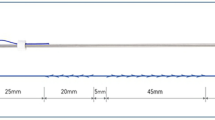Abstract
Mersilene (polyester monofilament) seems to be suitable for penetrating keratoplasty because it is strong, shows no degradation by ultraviolet light, is insoluble, so that it can be left in situ, and offers the possibility of regulating postoperative astigmatism by suture adjustment. In 12 patients penetrating keratoplasty was performed with the combined interrupted/running suturing technique, using eight interrupted nylon 10-0 sutures and one running Mersilene 11-0 suture. The results were compared with those of 25 patients in whom eight interrupted nylon 10-0 sutures and one running nylon 11-0 suture were used. Six months after penetrating keratoplasty, no differences could be found between the two groups in keratometric astigmatism, visual acuity or slitlamp findings. In three patients postoperative adjustment of the running Mersilene suture reduced astigmatism by 50, 90 and 100% respectively. In an animal study the behaviour of Mersilene in the cornea was evaluated by slitlamp examination, histology and electron-microscopy. The tissue response to Mersilene was minimal. Considering the resemblance to nylon in clinical findings, minimal tissue response, lack of biodegradation and possibility of regulating postoperative astigmatism by suture adjustment, Mersilene seems to be a suitable material for penetrating keratoplasty.
Similar content being viewed by others
References
Ulin AW. The ideal suture material. Surg Gynaecol Obstet 1971; 133: 475.
Aronson SB, Moore TE. Suture reaction in the rabbit cornea. Arch Opthalmol 1969; 82: 531–36.
Gurrierrez Sant L. Histopathological reaction of the new synthetic sutures in surgery of the anterior segment. Arch Sock Esp Oftal 1985; 48: 343–49.
Jongebloed WL, Rijneveld WJ, Cuperus PL, van Andel P, Worst JGF. Stainless steel as suturing material in human corneas: a SEM study. Doc Ophthalmol 1988; 70: 145–54.
Jongebloed WL, van der Veen G, Kalicharan D, Rijneveld WJ, Houtman WA, Worst JGF. Reaction of the rabbit corneal endothelium to nylon sutures: a SEM study. Doc Ophthalmol 1990; 75: 351–58.
Rijneveld WJ, Jongebloed WL, Worst JGF, Houtman WA. Comparison of the reaction of the cornea to nylon and stainless steel sutures, an animal study. Doc Ophthalmol 1989; 72: 297–307.
Bigar F. Astigmatismus nach Katarakt-Chirurgie: Vergleich nach Wundverschluss mit Nylonfaden und Mersilene. Klin Mbl Augenheilk 1990; 196: 314–15.
McNeill JL, Wessels IF, Adjustment of single continuous suture to control astigmatism after penetrating keratoplasty. Refract Corneal Surg 1989; 5: 216–23.
Kelly SE, Ehlers J, Llovera I, Troutman RC. Comparison of tissue reaction to nylon and prolene sutures in rabbit iris and cornea. Ophthalmic Surg 1975; 6: 105–10.
Binder PS. Selective suture removal can reduce postkeratoplasty astigmatism. Ophthalmology 1985; 92: 1412–16.
Stainer GA, Perl T, Binder PS. Controlled reduction of postkeratoplasty astigmatism. Ophthalmology 1982: 89: 668–76.
Lin DTC, Wilson SE, Reidy JJ, Klyce SD, McDonald MB, Kaufman HE, McNeill JL. An adjustable single running suture technique to reduce postkeratoplasty astigmatism. Ophthalmology 1990; 97: 934–38.
Cohan BC, Leenslag JW, Miles J, Pennings AJ. An evaluation of ultrastrong polyethylene fiber as an ophthalmic suture. Arch Ophthalmol 1985; 103: 1816–21.
van Meter WS, Gussler JR, Soloman KD, Wood TO. Postkeratoplasty Astigmatism Control. Ophthalmology 1991; 98: 177–83.
Frueh BE, Feldman ST, Feldman RM, Sossi NP, Frucht-Pery J, Brown SI. Running nylon suture dissolution after penetrating keratoplasty. Am J Ophthalmol 1992; 113: 406–11.
Author information
Authors and Affiliations
Rights and permissions
About this article
Cite this article
Ramselaar, J.A.M., Beekhuis, W.H., Rijneveld, W.J. et al. Mersilene (Polyester), a new suture for penetrating keratoplasty. Doc Ophthalmol 82, 89–101 (1992). https://doi.org/10.1007/BF00156998
Accepted:
Issue Date:
DOI: https://doi.org/10.1007/BF00156998




